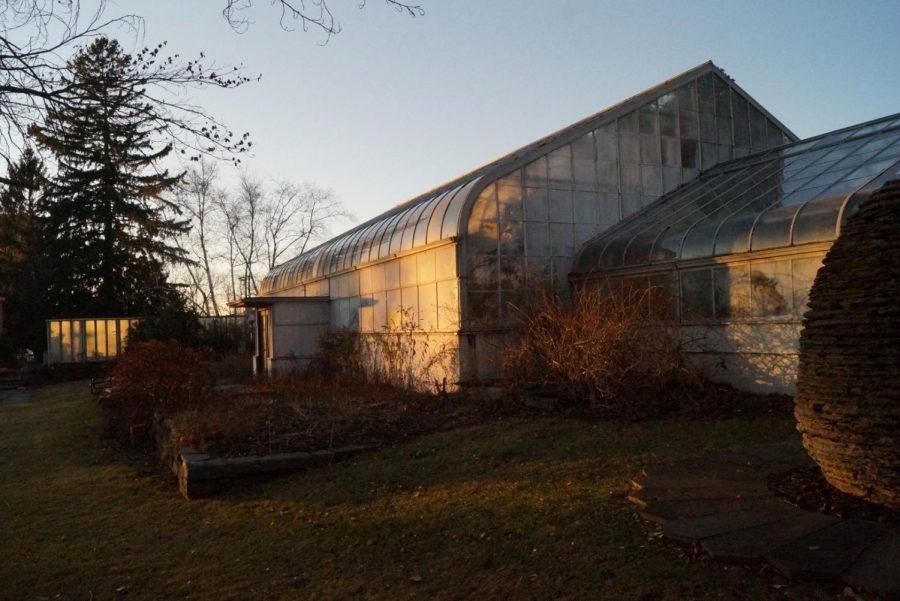Durfee Conservatory: UMass’ historic hidden oasis
A peaceful escape from constant hustle and bustle, right here on campus.
January 23, 2019
AMHERST — Nestled between the Life Sciences Laboratory and Franklin Dining Hall at the University of Massachusetts Amherst, a hidden sanctuary offers a peaceful escape from the anxiety and stress of being a college student.
Opened in 1867, the Durfee Conservatory is only four years younger than the university itself, and remains a popular getaway for students. Amherst native Emily Dickinson, who lived nearby and had a profound love for nature, also used to visit the conservatory.
The greenhouse complex offers five unique rooms, or ‘houses’, appropriately named for the contents of each: Bonsai-Camellia, Epiphyte/Vine, Tropical, Collections and Succulents. Although every room has its distinct characteristics, each boasts an array of exotic plants from around the world.
Some exotic plants featured in the conservatory include a Theobroma cacao — often referred to simply as a chocolate tree, a Bird of Paradise plant and a collection of historic camellia trees from the original conservatory. The Collections House holds the Mimosa pudica, also known as the “sensitive plant” because its leaves fold in when touched.
Michael Formosi, the conservatory’s manager for the past 11 years, keeps it alive and well. He runs the conservatory from 10 a.m. to 4 p.m. every weekday, watering plants and maintaining climate control. His office sits in the corner of the Succulent House, with a desk adorned with a computer, papers and a climate monitor keeping track of each room.
Formosi graduated from UMass’ Stockbridge School of Agriculture in 1988 with a degree in horticulture. He takes pride in his work and pays special attention to detail, ensuring that the climate of each room is carefully controlled. With plants from all around the globe, focus is perhaps the most important skill to creating an environment in which all plants can thrive.
“There is always something to do,” Formosi said.
For instance, the Tropical House must maintain a humidity level of about 71 percent, simulating the conditions that these plants are native to. If the humidity drops below this threshold, plants will start to show signs of stress, causing their leaves to turn brown. A watchful eye is paramount to assure that these plants survive in a New England environment.
Students can use the conservatory for a variety of activities, including studying, reading or meditating. One room in particular, the Tropical House, includes multiple wooden benches to unwind on while basking in the warm and humid atmosphere.
The center of the Tropical House boasts a wooden bridge stretching over an artificial 4,000-gallon pond. Nine crimson-orange koi fish inhabit the water, a favorite spectacle among passerby. A soft mist from the pipes above constantly sprays down onto the pond, granting the space an especially mystical atmosphere. The mist assists with keeping the humidity at a sufficient level for the plants.
Throughout its long life, the peace and quiet of the conservatory has been interrupted from time to time. The worst of these occurred in the winter of 1883; the greenhouse caught on fire due to the non-stop wood and coal furnace setting the original wooden arches aflame.
The students who were in charge of maintaining the fire throughout the day and night managed to preserve parts of the building and many plant specimens, but their frantic efforts were not enough to save the greenhouse. They utilized the light snow on the ground in an attempt to control the fire, but the flames had spread too quickly.
By 1892, the conservatory was fully restored to its former beauty, with completely new structures and systems. To ensure that the conservatory did not suffer the same fate again, the heating systems were improved and eventually replaced with a then-modern temperature control system. However, after decades of weathering and the destruction of one house by a falling oak tree, the conservatory needed attention again.
In 1954, the conservatory was in desperate need of reparation. Glass panes would fall without notice, wooden frames would crack and sway, and plants were not properly maintained. Upon confirmation of the imminent demolition of the conservatory, reporters at the Massachusetts Daily Collegian stated that “the old Durfee range, rotting frame and exotic flora struggling for survival, is no more.”
“Holding hands with their dates, couples strolled through the greenhouses lingering to admire the camellias and each other,” noted John Tristan, former manager and author of a “History of the Durfee Conservatory” of the 1950s.
The new Durfee Conservatory, built only a foot from its previous location, cost $69,684 to complete. This structure, made from metal instead of wood, was built to last and continues to prosper.
With winter quickly approaching, few places on campus offer the warmth and serenity that are available in the conservatory. The temperature in the Tropical House remains a constant 75 to 80 degrees Fahrenheit throughout the year, producing a stable environment for the tropical plants and a warm welcome for any chilly UMass student.
Visit the Durfee Conservatory website to learn more about its history, plants and purpose.
Email Matt at [email protected] or follow him on Twitter @MattBerg33.



